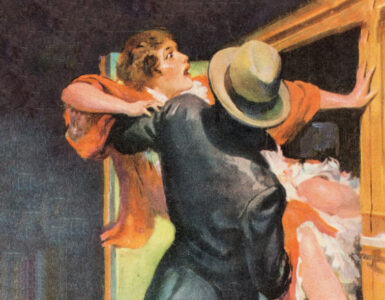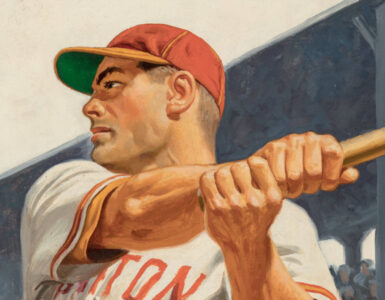Pulp magazines have influenced writers, artists, film directors, software developers, and countless others over the years. Our “PulpFest Historical” articles focus on the rough-paper writers, editors, publishers, and artists who have inspired and continue to inspire the creators of the world’s popular culture.
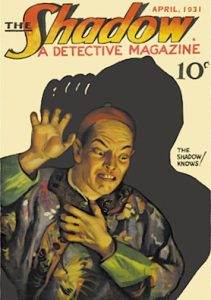 When Walter B. Gibson accepted Street & Smith’s assignment to write a story featuring a character called The Shadow, the 33-year-old author thought he’d be tied up for no more than a few months. After all, the publisher envisioned only four quarterly issues, just enough to establish a trademark on the character.
When Walter B. Gibson accepted Street & Smith’s assignment to write a story featuring a character called The Shadow, the 33-year-old author thought he’d be tied up for no more than a few months. After all, the publisher envisioned only four quarterly issues, just enough to establish a trademark on the character.
The Shadow had been introduced to the public on July 31, 1930. The character was the mysterious narrator for THE DETECTIVE STORY HOUR, a CBS radio program sponsored by the Street & Smith pulp chain.
When business manager Henry Ralston began to hear from newsdealers that their customers were not asking for DETECTIVE STORY MAGAZINE, but “that Shadow magazine,” he decided that the time might be ripe for a revival of the single-character magazine.
Founded in 1855, Street & Smith had achieved great success publishing dime novels featuring continuing characters such as Buffalo Bill, Frank Merriwell, and detective Nick Carter. Ralston envisioned a modernized version of the dime novel detective for the new pulp magazine. Providing an unpublished Carter story to the editorial staff, he suggested that they simply change Nick Carter to The Shadow and he would take care of the rest.
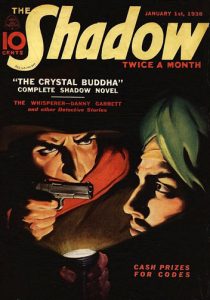 But Gibson had other thoughts. “I had this idea for a character who would be a mystery in himself … a cloaked, shadowy character who could move into the affairs of lesser folk.” Gibson’s Dark Avenger stood the conventional mystery on end: “I put people in jeopardy… and when … the sinister figure was coming in, he was somebody who was going to put an end to the menace. He was sort of like a benign Dracula.”
But Gibson had other thoughts. “I had this idea for a character who would be a mystery in himself … a cloaked, shadowy character who could move into the affairs of lesser folk.” Gibson’s Dark Avenger stood the conventional mystery on end: “I put people in jeopardy… and when … the sinister figure was coming in, he was somebody who was going to put an end to the menace. He was sort of like a benign Dracula.”
Gibson’s nascent idea was enough for Street & Smith editor Frank Blackwell. The young writer won the assignment to develop a novel-length story featuring The Shadow. If his efforts were satisfactory, he could write three more Shadow adventures to be published quarterly. But Gibson would do so much more.
At the beginning of March 1931, American newsstands debuted THE SHADOW: A DETECTIVE MAGAZINE. The first single character or hero pulp, it revived a fiction format that had disappeared following the demise of the dime novels and story papers. Author Walter B. Gibson — writing as Maxwell Grant — had refashioned the sinister narrator of THE DETECTIVE STORY HOUR into the first pulp hero.
Gibson’s character was a dark and mysterious crime-busting super-sleuth who embodied the iconic power of classic villains like Dracula. The Shadow served as the template for other pulp heroes and, later, scores of comic book superheroes. Gibson and his occasional fill-in, Theodore Tinsley, also introduced the concepts of super-crooks and super-crime.
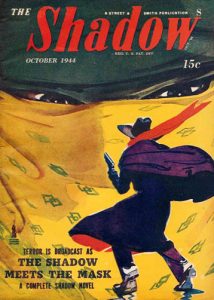 Envisioned as a one-shot or a quarterly at best, the magazine sold out the print runs of its first and second issues. The pulp was converted to a monthly beginning with its October 1931 number. A year later, it would become a semi-monthly, with two issues appearing every month until the paper shortages of World War II and changing tastes returned it to a monthly in 1943. Later that same year, it would become a digest magazine.
Envisioned as a one-shot or a quarterly at best, the magazine sold out the print runs of its first and second issues. The pulp was converted to a monthly beginning with its October 1931 number. A year later, it would become a semi-monthly, with two issues appearing every month until the paper shortages of World War II and changing tastes returned it to a monthly in 1943. Later that same year, it would become a digest magazine.
Lasting 325 issues and spanning eighteen years, THE SHADOW magazine was canceled in 1949. However, Gibson’s and Tinsley’s character had left an indelible mark on popular culture.
In his history and analysis of The Shadow’s adventures, the late Robert Sampson described the Street & Smith hero as, “Cold, remote, perceptive, he was part abstract force, part myth in contemporary trousers. His adventures affirmed virtue in a world without virtue.” In short, Walter B. Gibson had created an icon.
Although the storylines can be quite entertaining, they really come alive when The Shadow appears:
A man was standing in the corner. A black cloak, with lining of crimson, enveloped him. He wore a large slouch hat, and the turned-down brim obscured his features. The man’s arms were folded in front of his body; his hands were covered with thin, black gloves. He laughed again, softly, but mirthlessly. The sinister tone of his laugh seemed taunting. It ridiculed the words of Nick Savoli. It brought a tremor of fear to Mike Borrango. Then the man spoke: “You fear no one?” he asked, in a low, even voice, that carried the same uncanny tone as his laugh. “There is no one who can challenge you? Look at me, Nick Savoli … I am The Shadow!”
 This summer, PulpFest 2021 will honor the ninetieth anniversary of THE SHADOW MAGAZINE. The convention will celebrate the first hero pulp’s debut with panels and presentations about SHADOW cover artists, the connections between Walter Gibson and master illusionist Harry Houdini, Shadow advertisements and premiums, the character as a multimedia hero, and “Walter B. Gibson and His Shadow.” The latter will feature panelists Will Murray, Jim Steranko, and Anthony Tollin. All three knew Walter Gibson, the man who would write 283 of The Shadow’s adventures. The convention will also feature a festival of Shadow films, including rare episodes of film shorts based on THE DETECTIVE STORY HOUR radio program, narrated by The Shadow.
This summer, PulpFest 2021 will honor the ninetieth anniversary of THE SHADOW MAGAZINE. The convention will celebrate the first hero pulp’s debut with panels and presentations about SHADOW cover artists, the connections between Walter Gibson and master illusionist Harry Houdini, Shadow advertisements and premiums, the character as a multimedia hero, and “Walter B. Gibson and His Shadow.” The latter will feature panelists Will Murray, Jim Steranko, and Anthony Tollin. All three knew Walter Gibson, the man who would write 283 of The Shadow’s adventures. The convention will also feature a festival of Shadow films, including rare episodes of film shorts based on THE DETECTIVE STORY HOUR radio program, narrated by The Shadow.
“Who knows what evil lurks in the hearts of men? The Shadow knows!” Come August, so will attendees at PulpFest 2021.
When Street & Smith launched THE SHADOW on March 6, 1931, they were hedging their bets. Envisioned as a one-shot or a quarterly at best, editor Frank Blackwell offered The Shadow to a relatively unknown writer. Not only that, but Modest Stein’s cover art for the April 1931 issue had been used before. It originally ran as the cover for the October 1, 1919 issue of THE THRILL BOOK. Stein would later create at least forty-one new covers for THE SHADOW during the magazine’s later years — in both the pulp and digest formats — including the October 1944 number.
After the first two issues of THE SHADOW: A DETECTIVE MAGAZINE had sold out, it became obvious that Street & Smith had a hit on its hands. The magazine became a monthly with its third issue, with Jerome Rozen as the cover artist. After three additional Jerome Rozen covers, his twin brother George took over the cover duties for the popular magazine. George Rozen would paint nearly two hundred covers for the pulp — including the January 1, 1938 issue and the magazine’s final issue, dated Summer 1949. His art would also grace the covers of the 1942 and 1943 issues of THE SHADOW ANNUAL and the first six issues of Street & Smith’s SHADOW COMICS.
Graves Gladney rounds out the quartet of the leading cover artists for THE SHADOW. Beginning with the April 1, 1939 number and running through the September 15, 1941 issue, Gladney painted sixty covers (including the September 15, 1940 issue that heads our post) for the Street & Smith magazine. A freelance artist who also sold cover paintings to Fiction House, Popular Publications, and Standard Magazines, Graves Gladney painted the majority of his pulp covers for Street & Smith’s magazines. In addition to THE SHADOW, Gladney contributed cover art to ASTOUNDING SCIENCE-FICTION, THE AVENGER, CLUES, CRIME BUSTERS, STREET & SMITH’S MYSTERY MAGAZINE, SPORT STORY, and UNKNOWN.
Other artists who created covers for THE SHADOW include John Coughlin (the second issue), Charles Ravel (five covers), Walter Swenson (four covers), and Charles Coll (two covers, plus the cover art for the 1947 annual, as well as the covers for thirty issues of SHADOW COMICS). Charles DeFeo (the “Flag” issue in 1942), Bob Powell (the “comic book” cover in 1948), and William Timmins also contributed single covers to the magazine’s run of 325 issues. There’s also one photographic cover — the November 1937 number. The man posing as The Shadow is Bill Lawlor, Street & Smith’s, art director. The covers for four 1946 – 47 digest issues currently lack artist attributions (although we suspect they may be the work of Modest Stein).
Michael Chomko, the winner of the 2010 Munsey Award, is the marketing and programming director for PulpFest. A registered nurse, Mike sells books on a part-time basis, operating as Mike Chomko, Books. His specialty is pulp-related material. Married for over forty years, he is the father of two adult children, as well as a recent grandfather.


